Click on images to enlarge

infestation (Photo: Sheldon Navie)

habit (Photo: Sheldon Navie)
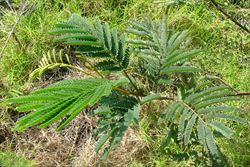
leaves (Photo: Sheldon Navie)
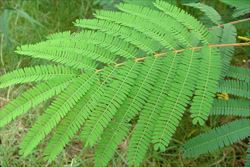
one of the large twice-compound leaves (Photo: Sheldon Navie)
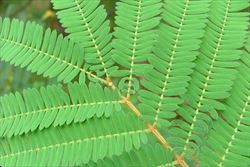
close-up of elongated leaflets and small raised gland between uppermost pair of leaf branches (Photo: Sheldon Navie)

close-up of stem, leaf stalk with large raised gland, and young flower clusters (Photo: Sheldon Navie)

flower cluster (Photo: Greg Jordan)

close-up of flowers (Photo: Trevor James)
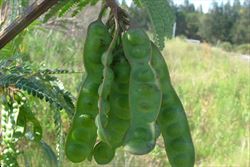
immature fruit (Photo: Sheldon Navie)
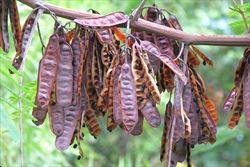
clusters of mature fruit (Photo: Sheldon Navie)
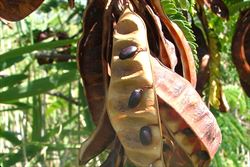
close-up of mature fruit with seeds (Photo: Sheldon Navie)

seedling (Photo: Trevor James)
Scientific Name
Paraserianthes lophantha (Willd.) I.C. Nielsen subsp. lophantha
Synonyms
Acacia lophantha Willd.Albizia distachya (Vent.) J.F. Macbr.Albizia lophantha (Willd.) Benth.Mimosa distachya Vent.Mimosa elegans AndrewsMimosa lophantha (Willd.) Pers.Mimosa venustula Dum. Cours.Paraserianthes lophantha (Willd.) I.C. Nielsen var. lophantha
Family
Fabaceae: sub-family Mimosoideae (New South Wales)Leguminosae (South Australia)Mimosaceae (Queensland, the ACT, Victoria, Tasmania, Western Australia and the Northern Territory)
Common Names
albizia, Australian albizia, brush wattle, Cape wattle, Cape Leeuwin wattle, crested wattle, plume acacia, plume albizia, plume-albizia, stink bean, stinkbean, swamp wattle
Origin
Native to some parts of Western Australia (i.e. the coastal districts of south-west Western Australia from Fremantle to King Georges Sound).
Cultivation
Widely cultivated as an ornamental plant, particularly in the coastal districts of southern Australia.
Naturalised Distribution
Widely naturalised in southern Australia (i.e. in many parts of eastern New South Wales, in Victoria and Tasmania, in many parts of South Australia and on Norfolk Island). Also naturalised beyond its native range in south-western Western Australia.
Naturalised overseas in New Zealand, south-western USA, Chile, southern Africa, the Canary Islands and the Azores.
Habitat
A weed of coastal sand dunes, coastal woodlands, riparian areas, wetlands, open woodlands, forest margins, roadsides and disturbed sites in wetter temperate regions.
Habit
A shrub to medium-sized tree usually growing 2-8 m tall, but occasionally reaching up to 10 m in height.
Distinguishing Features
- a shrub to medium-sized tree usually growing 2-8 m tall.
- its twice-compound leaves (15-30 cm long) have 7-14 pairs of branchlets.
- each leaf branchlet bears 15-40 pairs of small leaflets (4-11 mm long).
- its flowers are arranged in elongated clusters (4-8 cm long) borne singly or in pairs in the upper leaf forks.
- these yellow or greenish-yellow flowers have numerous prominent stamens (6-8 mm long).
- its fruit are elongated and flattened pods (6.5-12 cm long and 1.5-3 cm wide) that turn brown or reddish-brown when mature.
Stems and Leaves
Its stems are finely hairy (i.e. puberulent) with ridges that run from the bases of the leaf stalks.
Its alternately arranged leaves (15-30 cm long) are twice-compound (i.e. bipinnate) and borne on stalks (i.e. petioles) 3-7 cm long. These leaves have 7-14 pairs of branchlets (i.e. pinnae), each of which is 3-12 cm long and bears 15-40 pairs of leaflets (i.e. pinnules). The leaflets (4-11 mm long and 1-4 mm wide) are narrowly-oblong in shape with entire margins and pointed tips (i.e. acute or mucronate apices). There is a prominent raised structure (i.e. gland) about halfway along the leaf stalk, and there is sometimes another smaller gland present between the last pair of branchlets (i.e. terminal jugary gland). The leaf stalk and branchlets are finely hairy (i.e. puberulent), while the leaflets are hairless (i.e. glabrous) or sparsely hairy (i.e. puberulous) underneath.
Flowers and Fruit
The flowers are arranged in elongated clusters that are borne singly or in pairs in the upper leaf forks (i.e. axillary racemes). These clusters (4-8 cm long) are borne on stalks (i.e. peduncles) 0.7-3 cm long and contain large numbers of small yellow or greenish-yellow flowers. Each flower is borne on a short stalk (i.e. pedicel) 1.5-3 mm long. These flowers have five tiny sepals (2-3 mm long) and five small petals (4-6 mm long), as well as numerous more prominent stamens (6-8 mm long). Flowering mostly during late winter (i.e. in July and August).
The fruit are elongated and flattened pods (6.5-12 cm long and 1.5-3 cm wide) that are borne on stalks 1-2 cm long. These pods are hairless (i.e. glabrous) and turn from green to brown or reddish-brown in colour as they mature. Each pod contains 6-12 dark brown or black seeds (6-8.5 mm long, 4.5-5.5 mm wide and 3-4 mm thick) that are oval in shape (i.e. elliptic).
Reproduction and Dispersal
This species reproduces by seed. The seeds are spread by wind and water, and are also dispersed in dumped garden waste.
Environmental Impact
Cape Leeuwin wattle (Paraserianthes lophantha subsp. lophantha) is regarded as an environmental weed in Victoria, New South Wales, Tasmania and South Australia. It was also recently listed as a priority environmental weed in at least one Natural Resource Management region.
Legislation
Not declared or considered noxious by any state government authorities.
Management
For information on the management of this species see the following resources:
- the Cape wattle page on the South Coast Weeds website at http://www.esc.nsw.gov.au/Weeds/index.asp.

